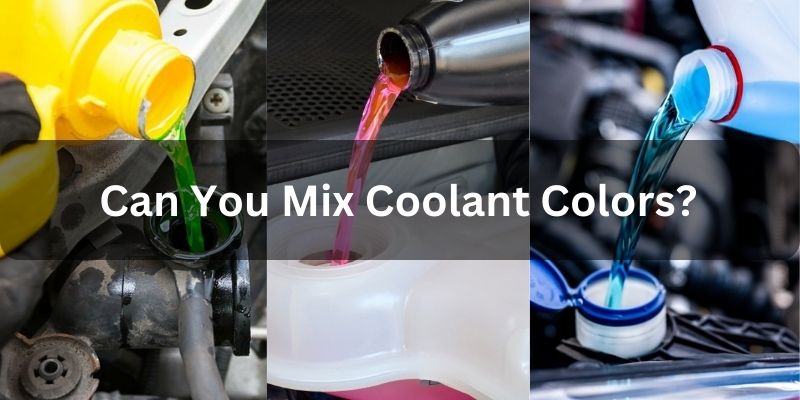Mixing different types of coolant is a concern for many car owners. Coolant plays a crucial role in keeping your engine running at the proper temperature. Using the wrong coolant or mixing incompatible coolant color types can lead to serious damage.
This article explains how can you mix coolant colors, the potential issues with mixing different types of coolant brands, proper maintenance and flushing, and how to choose the right coolant for your vehicle.
Can You Mix Different Coolant Colors?
According to automotive industry experts, it is not best to mix different coolant colors as some colors may indicate similar coolant technology, but the dyes and inhibitor formulas can still differ across brands and types.
Your owner’s manual will state explicitly if you can safely mix coolants from different manufacturers or mix colors such as green and yellow. When in doubt, do not mix different colors. Stick with one type of coolant.
Types of Coolant Colors and their meanings
Coolant comes in a variety of color dyes to differentiate types:
Green
Green is the original color of early conventional coolants with silicates and phosphates. Should not be mixed with OAT or IAT coolants. These are the most used coolant in classic cars.
Orange
Indicates a Dex-Cool or OAT coolant. Should not be mixed with conventional green or other OAT formulations.
Red
This may indicate a nitrite-free hybrid OAT coolant. Do not mix with green.
Blue
Used for hybrid OAT coolants. Should not mix with green or orange OAT types.
Yellow
Used in heavy-duty diesel engines. Do not mix with other types.
Pink
Used in some OAT and HOAT coolants. Do not mix with green.
The color alone does not definitively indicate compatibility. Check your owner’s manual or coolant packaging to determine the specific type before mixing.
What is Coolant and What Does it Do?
Coolant, known as antifreeze, is a liquid that circulates through your engine to keep it from overheating. It has three main jobs:
– Prevents freezing in cold temperatures
– Lowers the boiling point to prevent overheating
– Protects against corrosion
Coolant is typically a mix of water and coolant additives. The additives like ethylene glycol lower the freezing point and raise the boiling point. They also contain corrosion inhibitors to prevent rust and scale buildup inside the cooling system.
Different Types of Engine Coolant By Additives
There are a few main types of engine coolant available:
Green
The traditional green-colored ethylene glycol coolant. Provides corrosion protection and freezing/boiling point for around 2 years.
HOAT
Hybrid Organic Acid Technology coolant. Provides longer corrosion protection, typically 5 years or 150,000 miles. Compatible with green coolant.
OAT
Organic Acid Technology coolant. Does not contain silicates, phosphates, or borates. Provides the longest corrosion protection, typically 5 years or 150,000 miles. Incompatible with green and HOAT coolants.
IAT
Inorganic Acid Technology coolant. Phosphate and silicate free. Used in heavy-duty applications. Not compatible with other types.
Why You Should Not Mix Different Types of Coolant
The big concern with mixing different types of coolant is corrosion and damage to your engine’s cooling system. Each type contains different formulations of additives and inhibitors. Mixing incompatible coolants can cause the additives to react with each other, forming gel, sludge, and scale. This can clog up your radiator, water pump, and thermostat.
For example, mixing a silicate-based coolant with a non-silicate coolant causes the silicates to solidify and form an abrasive scale. OAT coolants should never be mixed with IAT, HOAT, or traditional green coolants. Doing so will greatly reduce the corrosion protection abilities of the OAT coolant.
Potential Issues from Mixing Incompatible Coolants
Here are some of the possible issues that can arise from mixing incompatible types of engine coolant:
– Blocked radiator and heater cores from sludge and gel formation
– Leaks from corrosion and erosion of gaskets and seals
– Water pump failure from abrasive scaling
– Overheating due to blocked coolant flow
– Engine damage from overheating or corrosion
– Voided manufacturer warranty due to incorrect coolant usage
To avoid these problems, you should avoid mixing different types of antifreeze unless explicitly stated on the coolant packaging that they are compatible.
What Happens When You Mix Coolant Colors?
Here’s what may happen if you improperly mix different colored coolants:
– The corrosion inhibitors can react and lose effectiveness, leading to rust and erosion inside the cooling system. This can cause coolant leaks and clogs.
– Chemical reactions between additives can form gels, solids, and abrasive sediment that blocks coolant flow and causes overheating issues.
– Seal and gasket materials may degrade if the mix of coolants turns more acidic or alkaline. This can lead to leaks.
– Your engine components are put at risk of corrosion damage with depleted inhibitor levels in the mixed coolant.
– You may void the warranty coverage on your engine and cooling system components by using an incorrect coolant mixture.
To prevent these issues, avoid mixing any coolants unless the manufacturers guide that it is compatible and safe to mix.
When Should You Flush Your Coolant?
Coolant should be flushed according to your vehicle manufacturer’s recommendations, typically every 2-5 years or 30,000-150,000 miles. You should also flush the system any time you switch coolant types or notice contaminants in the coolant.
Signs it’s time for a flush include:
– Discolored or dirty coolant
– Foaming radiator fluid
– Engine overheating issues
– Sweet smell indicating antifreeze leaks
How to Flush Old Coolant from Your Vehicle
Flushing old contaminated coolant from your system helps provide maximum corrosion protection when switching coolant types. Here are the steps:
1. Allow the engine to completely cool if recently running.
2. Drain the existing coolant from the radiator petcock and engine drain plug.
3. Fill with distilled water and run the engine to operating temperature. This will circulate water throughout the system.
4. Drain distilled water completely.
5. Refill with new coolant as recommended by your owner’s manual. Bleed air from the system.
6. Inspect hoses, clamps, radiator caps, and water pump for any needed replacements.
Choosing the Right Coolant for Your Vehicle
When selecting a new coolant, make sure to choose the specific type recommended for your make and model vehicle. Consult your owner’s manual for the correct coolant specs.
Key factors to consider in a coolant:
Intended usage
Light duty or heavy duty/diesel engine application
Base fluid
Ethylene glycol, propylene glycol, or a hybrid
Additive technology
OAT, HOAT, conventional green, or IAT coolants
Color
Match the original factory-fill color if possible
Mixing compatibility
Do not mix with any other coolant types unless explicitly allowed
Using the manufacturer-recommended coolant is important to maintain corrosion protection and avoid engine damage. Make sure to flush the system thoroughly when switching coolant types.
How long can you drive with mixed coolant?
Driving with mixed coolant is not recommended, and it is advisable to address the issue promptly. Continuing to drive with mixed coolant can potentially lead to engine damage or overheating.
It is best to drain and flush the cooling system as soon as possible to prevent any further complications.
Can you mix green and orange coolants?
No, do not mix green ethylene glycol coolant with orange Dex-Cool or OAT coolants. This can cause sludge, gelation, and shortened corrosion protection.
Is it okay to mix different brands of the same coolant?
Avoid mixing different brands even if they are the same color and type. Additive formulas can differ between manufacturers and may be incompatible.
Can you use just water instead of coolant?
No, plain water by itself provides no antifreeze protection, boils too easily, and promotes corrosion. Always use a proper water/coolant mixture. But it can be used as a temporary fix for overheating cars.
Is tap water safe to mix with antifreeze?
No, it’s not safe to mix water with antifreeze as tap water contains minerals that can cause scaling and corrosion. Use distilled or deionized water when mixing concentrated coolant.
What color is ethylene glycol?
Ethylene glycol is a mostly clear and colorless liquid under normal conditions. It may give a fluorescent yellowish-green color due to light scattering within the liquid rather than any inherent color pigments.
Can you mix peak antifreeze with other antifreeze?
All antifreeze types contain similar ingredients, it’s best not to mix brands without checking if they are compatible. The concentration of additives could conflict or chemicals may precipitate out of solution.
It’s better to stick with the same brand when topping off or changing fluid. It’s safer than risking any unwanted reactions between formulations.
Can you mix 50/50 antifreeze with regular antifreeze?
No, it’s not good to mix 50/50 premixed antifreeze with a regular concentrate. The 50/50 formulation already has water mixed in, while the concentrate would need to be diluted.
Combining the two could result in the antifreeze mixture being either too strong or weak in concentration, risking freezing/boiling over protection issues. It’s best to stick with either 50/50 or concentrate, not both.
Can you mix orange and red coolant?
While both orange and red-colored coolants serve the same purpose, it’s typically not recommended to mix them together. The dye and additive packages could be incompatible, potentially causing pigment instability or saturation issues that affect the coolant’s ability to circulate and protect your system.
Can you mix the same color coolants?
No, it’s not safe to mix the same color coolants. Mixing the same color coolants from different manufacturers can still carry some risks, even if they appear identical.
Variations may exist in concentration levels, additive packages, or pH balance between brands that could potentially negate warranty coverage or compromise performance over time.
Can you mix yellow and orange antifreeze?
Yes, you can mix yellow and orange antifreeze. Both coolants are ethylene glycol base and corrosion inhibitor packages are similar between differently colored products. Additionally, they both are formulated with organic acid technology.
The dye used to produce the color is merely aesthetic and should not impact performance or longevity when blended.
Can you mix blue and orange coolant?
No, mixing blue and orange coolants together is not a good idea. They both serve to cool engines effectively on their own. Their unique formulations were designed independently and may not be fully compatible when joined.
Problems could potentially arise from an unpredictable reaction between the two.
Can you mix blue and green coolant?
Yes, blue and green coolants can be mixed if their formulation is the same. Most ethylene glycol-based coolants come in green and blue color and these coolants can be mixed.
Is coolant red?
Red coolant, often referred to as “red antifreeze,” is a type of engine coolant with a distinct reddish-pink hue. It typically contains organic acid technology (OAT) or hybrid organic acid technology (HOAT) additives.
Most modern coolants come in red colors that’s why it is commonly named red coolant.
Conclusion
Mixing incompatible types of engine coolant can lead to serious maintenance issues and damage. Always check your owner’s manual for the correct coolant to use. Thoroughly flush the system when switching antifreeze types. If in doubt, stick with the same coolant color and brand as originally equipped from the factory for optimal performance and safety.

Hi, Michael Williams here. I have always loved everything with an engine. After earning my degree in automotive engineering, I spent 5 years testing vehicles for a major manufacturer in Illinois. Now I am using my technical skills to review the latest models online and help others troubleshoot their engine problems with effective solutions.
